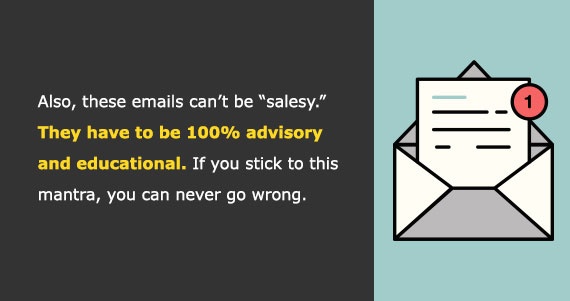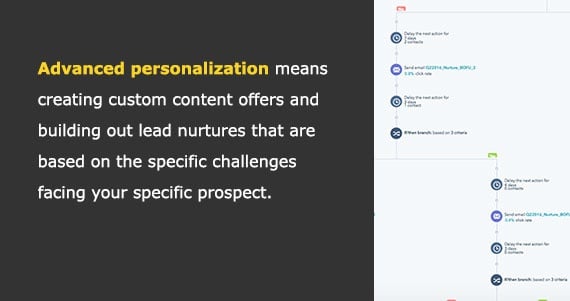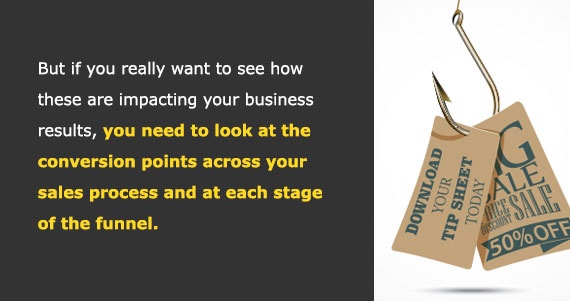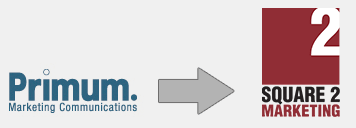
Once Your Prospects Convert, The Key Is Proper Lead Nurturing
Get Your Prospects To Know, Like And Trust You
Lead nurturing has one goal: keep the conversation going with leads at all stages of the buyer journey. If you can deliver solid guidance, educational information and advice in perfect context to their journey and their challenges, you can position your company as the one they want to do business with.
Now when their pain becomes acute, they don't start their search, they just reach out to you — falling beautifully out the bottom of your sales funnel and right into your sales organization's hands.
Plan Your Lead Nurturing To Match The Sales Cycle
You want to match your lead nurturing workflow timing to match your sales cycle. If your sales cycle is 30 days, then your lead nurturing should be no more than a series of three emails sent every three days. If those convert in the 40% to 60% range for open rate and between 30% and 40% for click-through rate, you're killing it. Anything less is going to require some testing and adjustments over time, but I'd recommend you keep the timing the same.
If you have a 12-month sales cycle, then you're going to need a longer nurture time frame. I would suggest you stick with the three-email, three-day sequence, but then bring those back every six weeks or so to remind your new prospect how your company is obsessed with being a trusted advisor.

Remember, you also have regular educational emails going out to these same people. Your general email marketing is a supplement to these lead nurturing campaigns. This allows you to take a breath and let the prospect breathe. Make sure you orchestrate these two email programs perfectly, so the messages are complementary and there are no mixed messages.
Make Your Communication Remarkable, Which Will Equal Memorable
What you say is more important than how you say it or how often you say it. These touch points are critical to establishing your brand, your message, your stories, your disruption of the prospect's status quo and, ultimately, your ability to turn these opportunities into new customers.
These emails need to be remarkable. They need to be written elegantly. They can't be too long, or else they won't get read, so you need to keep them short and choose your words carefully. They need to differentiate your company, your brand and your product or service from your competitors. These same prospects might be getting emails from your competitors. If your emails are better, sharper and more interesting, you're going to out-market your competition. This would be "mission accomplished" in my book.
Personalize The Nurture Campaign To Be Contextual To Their Challenges
We want this resource to be helpful to people at all stages of their inbound marketing adventure. Basic personalization means using the prospect's name in the email. If you want to go further, then you can include company names, roles or industry information in the body of the email.

For example, you can run a complete reporting email sequence if reporting is a big challenge to your prospect. You can run a complete sequence based on data quality if that is their hot button or pain point.
You might also want to consider running branch campaigns based on their behavior within the lead nurture workflow. But before you go crazy, keep in mind that you might end up with a huge mess of complicated branch campaigns that never pay off. Build these more complicated nurtures based on performance data. If it works, keep doing it. If it doesn't, stop. This should prevent you from getting too big, too fast and needing help unwinding everything to figure out what's working and what's not.
Track Campaign Metrics And Set Campaign Expectations
It's all about the numbers. In most cases, those are funnel metrics. Yes, you want to track open rates, click-through rates, opt-out rates, forward rates and the conversion on specific offers within pages that the emails are directing people to visit. These are the metrics everyone is keen to watch.

How many MQLs (marketing-qualified leads) are turning into SQLs (sales-qualified leads)? This is an indicator that your lead nurturing is moving those awareness folks down into consideration. What percentage of SQLs are actually sales opportunities? This could be an indication as to the quality of your leads, but it might also indicate whether your lead nurturing is helping prospects to feel safe and if it's contributing to them understanding pain.
Sales opportunities are synonymous with people who express interest in buying something. They've emerged at the bottom of the funnel and are asking decision-making questions (in other words, asking for a proposal, recommendations or your agreement). If these conversion metrics are increasing, your lead nurturing campaigns are probably contributing.
Setting expectations at the start of your lead nurturing work is important. If you think lead nurturing is the difference between success and failure this year, you're going to be disappointed. Lead nurturing is simply one of the many tactics that need to be executed as part of your orchestrated inbound marketing program. It won't work without it, nor will lead nurturing work without the other components.
You need great content to highlight in the nurturing. You need a great website to drive prospects back to. You need compelling, emotional stories and messaging to include in the emails.
You need the sequencing to be correct, which means testing and experiments. You need the technology to automate the creation, distribution and tracking of all these tactics. Your expectations should be that the metrics we talked about above and the business results associated with the effort are improving slowly, month over month.
If you can improve the numbers a little bit month over month, you'll be moving in the right direction.
Lead nurturing is one of those tactics that everyone knows they should be doing, but most people do it incorrectly. The definition of correct is not mine, it's yours. Lead nurturing either works because it's done right, or it doesn't work because you're doing it wrong. The measure of right is simply based on open rate, click-through rate and flow through the funnel, which means top-of-the-funnel leads are converting on middle- or bottom-of-the-funnel offers in your nurture campaigns. People in your nurtures are becoming customers. That's it.










